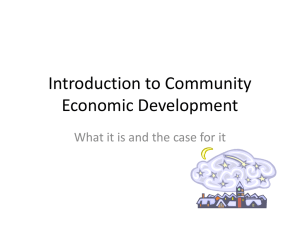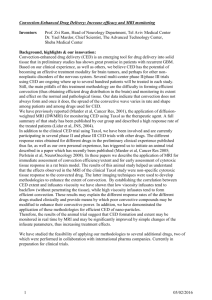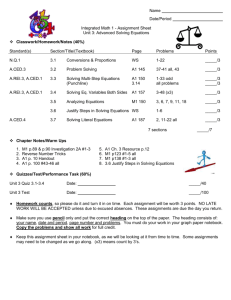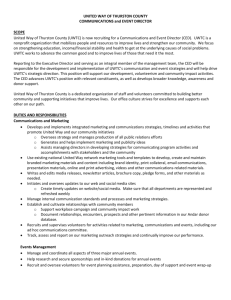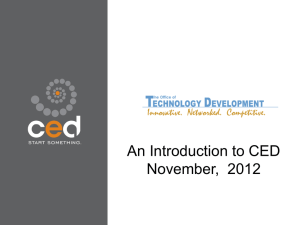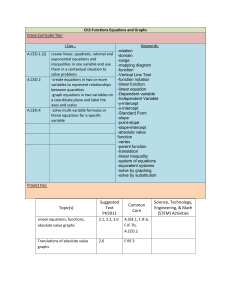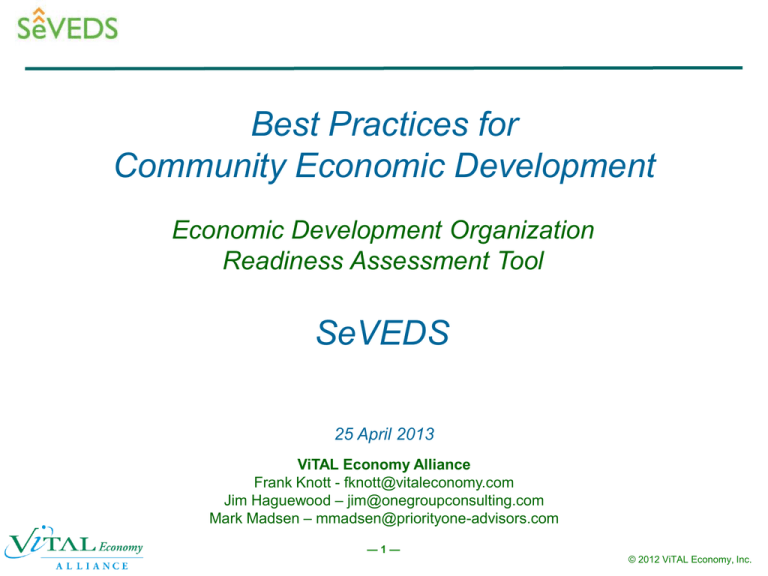
Best Practices for
Community Economic Development
Economic Development Organization
Readiness Assessment Tool
SeVEDS
25 April 2013
ViTAL Economy Alliance
Frank Knott - fknott@vitaleconomy.com
Jim Haguewood – jim@onegroupconsulting.com
Mark Madsen – mmadsen@priorityone-advisors.com
—1—
© 2012 ViTAL Economy, Inc.
Terms of Use
Limited License. Subject to these Terms of Use, we grant to the local sponsor and its funding
partners for this Best Practice for Community Economic Development, Readiness Assessment
Tool a non-exclusive, non-transferable, limited license to access and use the information, text,
graphics, data, and other content in this report for their personal, noncommercial use. You may also
incorporate portions of the content of this report in documents and other works of authorship that are
mainly the product of your own intellectual effort, and may distribute and disseminate those documents
and other works, but only if neither you nor anyone else receives any payment or other value that is
primarily attributable to the content used.
Proprietary Rights. You acknowledge that the content of this report is the property of ViTAL
Economy, Inc. and is protected by copyright, trademark and other intellectual property laws. You agree
not to use this content for any unlawful or unauthorized purpose, or in any manner that would harm the
reputation of ViTAL Economy, Inc. or its partners. You agree not to use any name, emblem, logo, or
trademark of ViTAL Economy, Inc. in any manner, except in the form of attribution and copyright notice
required by these Terms of Use.
Copyright Notice. On any print-out, download, or copy of this content you make that does not already
include a copyright notice, you agree to include a copyright notice as follows: "Copyright © 2013,
ViTAL Economy, Inc. All rights reserved.”
—2—
© 2012 ViTAL Economy, Inc.
Table of Contents
Economic Development: Art and Science........................................ 4
Fundamentals................................................................................... 5
Open Systems Planning Model........................................................ 6
How to Use the Assessment Tool..................................................... 7
10 Best Practices of Regional CED.................................................. 8 & 9
Assessment Questions ................................................................... 10-29
What we do really well?.................................................................... 31
Where can we improve? How? By When....................................... 32
—3—
© 2012 ViTAL Economy, Inc.
Economic Development: Art and Science
This assessment tool is intended to assist economic development organization Directors and
Leadership in elevating their organization and regional CED system through a disciplined
comparison against industry best practices in CED, thereby benefiting the entire region.
Nothing is more critical to your success as regional agents for change than an honest
assessment of your region’s practices conducted in the spirit of TQM continual improvement
principals.
This assessment tool compares the regional
CED system against Ten CED Best Practices
• Each of the ten elements poses four
qualitative and/or quantitative questions
for depth of analysis
• Each question should enable the CED
system and partner organizations to
identify areas where they excel, need
improvement, and where they can
introduce new standards of excellence
that will benefit their region
—4—
© 2012 ViTAL Economy, Inc.
Fundamentals
CED – Community Economic Development is a holistic balanced approach which
addresses Economic Vibrancy, Human Capital, and Quality of Place, all in the context of an
Innovation Ecosystem fostering a 21st Century Knowledge Based Economy.
Collaboration in a transformative CED effort requires significant effort to reach out across
traditional geo-political boundaries to empower Private, Public, and Non-Profit sector leaders
and citizens to take responsibility for their own regional economy.
True collaboration requires a commitment to Open Systems Planning where each
collaborator willingly and openly shares information and resources. Open systems can
efficiently exchange information, resources and knowledge, closed systems cannot.
This Readiness Assessment tool has been adapted from the ViTAL Economy Regional
CED Best Practices™ guide with input from the National Association of Development
Organizations (NADO). The objective is to assist regional CED organizations to adapt best
practices into their organization that will be of significant benefit throughout the entire region
as they work to improve their community and economy.
Total Quality Management (TQM) principles use strategy, data, and effective
communication to integrate quality improvement principles into the culture and activities of
the CED system and partner organizations. The regional CED Best Practices elements
presented herein are TQM principles applied to Community Economic Development.
—5—
© 2012 ViTAL Economy, Inc.
Vital Economy Open Systems Planning Model
• Innovation, Entrepreneurship, Incubation
• Tech Transfer, Producing Products & Services
• Market Needs
Local => Global
• Leveraging Indigenous Resources
• Indigenous
Resources &
Assets
• Mobilizing across regions and industry sectors
Regional CEDS
• Connecting the Dots Collaboration & Critical Mass
• Community vision &
goals
• Knowledge &
Creativity
• Products & Services
• Entrepreneurs
• Jobs, Wages &
Benefits
• Workforce Skills &
Capacity
Input
Transformation
Output
• Access to Capital
• Attitudes, Hopes
& Fears
• Barriers &
Enablers to
business
Effective Open Systems
Planning leverages shared
information rather than
controlling information
• Quality of Place
• Community
Prosperity & Civic
Pride
• Economic Growth
• Capital Generation
for Reinvestment
Feedback Loop = Fueling the Future
—6—
© 2012 ViTAL Economy, Inc.
Using the Assessment Tool
This assessment tool is best employed in a peer-facilitated review. It is recommended that
the assessment be conduced in a group setting to obtain a broad perspective and enable an
system-wide learning occasion. You are assessing your regional CED system, inclusive of
the individual partner organizations which collaborate on a consistent basis for economic
development.
1. For each question, rank the CED system for its performance over the past 2-5 years.
2. List major barriers the system faces for each of the Ten Best Practice elements
3. Highlight areas of strength – What does the CED system do really well? The answer
may lie outside the questions posed by the assessment tool. Answers may come from a
particular strength of one or more partner organizations
4. Discuss and record areas for improvement and actions for implementing Best Practices
into the CED system and partner organizations
5. Prioritize actions and next steps.
6. These actions and next steps become a guide to continual improvement in the spirit of
Total Quality Management (TQM) principles.
—7—
© 2012 ViTAL Economy, Inc.
Regional CED Best Practices – #1-5
1. Regional Collaboration: Meaningful & sustainable grass-roots collaboration
across public, private, non-profit and traditional political boundaries
2. Leadership Excellence: Empowers proactive leadership to take ownership
of their economy; grows leaders with accountability, authority, legitimacy &
transparency
3. Change Management: Adopts the eight steps critical to managing change
that enables the region to more effectively participate and compete in the
global economy
4. Balanced Approach: Integrates economic development, education &
workforce development assets with the private sector to build effective
knowledge based economic, human capital & quality of place centers of
excellence
5. Asset Based Approach: Identify, connect and leverage tangible and
intangible assets to sustainably grow and transform the regional economy
—8—
© 2012 ViTAL Economy, Inc.
Regional CED Best Practices # 6-10
6. Measurable Outcomes: Employs measurable benchmarks, goals and
strategies which transform the region through measurable outcomes
7. Innovation & Entrepreneurship: Builds innovation ecosystems that create
a lasting regional climate of entrepreneurship, risk taking and innovation
8. Life Cycle Finance: Provides access to a life cycle of equity and debt
financing for regional public, private and non-profit ventures
9. Regional Brand Promise: Defines, creates, communicates and delivers on
a clear brand promise that promotes & sustains regional competitive
advantages
10. Regional Transformation Mindset: Sustains commitment to CED as a
journey that is a marathon not a sprint, transformative not incremental
—9—
© 2012 ViTAL Economy, Inc.
Regional CED Best Practices – #1
1. Regional Collaboration: Meaningful & sustainable grass-roots collaboration across
public, private, non-profit and traditional political boundaries
Questions
Low
1
Examples of substantial
Public/Private collaboration across
the CED system over the last 5 yrs.
Low
1
Examples of substantial Non-Profit
Collaboration in CED over the last
5 years
Low
1
Demonstrated results of Public
Sector collaboration across political
boundaries for CED
Low
1
How effective has the CED system
been in fostering broad-based
collaboration?
Low
1
2
Med
3
2
Med
3
2
Med
3
2
Med
3
2
Med
3
4
High
5
4
High
5
4
High
5
4
High
5
4
High
5
— 10 —
© 2012 ViTAL Economy, Inc.
Regional CED Best Practices – #1
1.
Regional Collaboration: Meaningful & sustainable grass-roots collaboration
across public, private, non-profit and traditional political boundaries
Comments: Examples of Collaboration:
•
•
•
•
•
SeVEDS & BDCC with state and several towns
Waterline extension business plan competition Brooks House
BF Waypoint center
MS Chamber with two towns and several private businesses
Bi town effort
We’re moving the needle. Collaboration efforts are a lot different then five years ago
•
•
•
•
•
•
•
•
•
•
EDA grant
Co-op building
Grafton Cheese
Pending major hospital collaboration
EDA Flood Grant
Molly Stark, CT River byway
Route 100 byway
CDBG-DR
Whitingam/Wilmington school collaboration
WRC Brownfields program
Perceived Barriers: Advances in collaboration have come primarily because of individuals sitting
in individual chairs.
We need to institutionalize a culture of collaboration!
— 11 —
© 2012 ViTAL Economy, Inc.
Regional CED Best Practices – #2
2. Leadership Excellence: Empowers proactive leadership to take ownership of their
economy; grows leaders with accountability, authority, legitimacy & transparency
Questions
Low
1
Does the CED system’s leadership
body consist of 60% Private and
20% Non-Profit sector leaders.
Low
1
Are leaders involved in strategy
development and implementing
sub-committees?
Low
1
Is there a consistent leadership
development system in place?
Low
1
Does the CED system employ the
Open Systems Planning Model?
Low
1
2
Med
3
2
Med
3
2
Med
3
2
Med
3
2
Med
3
4
High
5
4
High
5
4
High
5
4
High
5
4
High
5
— 12 —
© 2012 ViTAL Economy, Inc.
Regional CED Best Practices – #2
2.
Leadership Excellence: Empowers proactive leadership to take ownership
of their economy; grows leaders with accountability, authority, legitimacy &
transparency
Comments: #SeVEDS is majority private sector and BDCC is also – WRC is municipal representation
Leaders involved in strategy development and impose committee – SeVEDS on its way
Perceived Barriers: Not enough younger people involved.
Don’t have a leadership development process.
Don’t have a habit of identifying and engaging potential leaders
Weak network
Not enough change – change creates opportunities for people to rise up.
— 13 —
© 2012 ViTAL Economy, Inc.
Regional CED Best Practices – #3
3. Change Management: Adopts the eight steps critical to managing change that enables
the region to more effectively participate and compete in the global economy
Questions
Low
1
Record of willingness to embrace
change and proactive
responsibility for economy
Low
1
Examples of analysis of regional
economic change in the face of
global economic forces
Low
1
Understanding of change
management concepts and its role
in CED
Low
1
Is there a defined and measurable
sense of urgency that has been
communicated
Low
1
2
Med
3
2
Med
3
2
Med
3
2
Med
3
2
Med
3
4
High
5
4
High
5
4
High
5
4
High
5
4
High
5
— 14 —
© 2012 ViTAL Economy, Inc.
Regional CED Best Practices – #3
3.
Change Management: Adopts the eight steps critical to managing change
that enables the region to more effectively participate and compete in the
global economy
Comments:
We might have groups willing to embrace change – but in aggregate it can be dysfunctional as various groups aren’t
going in the same direction
Attempts at looking at responding to energy global economic forces – businesses are good at it
Is there a defined sense of urgency that has been communicated – how do you measure it? I think it’s getting out there
There is some sense that people come here because there is no change. Things remain stagnant People know something’s is wrong – that don’t necessarily make the connect to economic development
People define it in terms of their property taxes
Perceived Barriers: We get in our own way
— 15 —
© 2012 ViTAL Economy, Inc.
Regional CED Best Practices – #4
4. Balanced Approach: Integrates economic development, education & workforce
development assets with the private sector to build effective knowledge based economic,
human capital & quality of place centers of excellence
Questions
Low
1
Does the CED system engage
Education & Workforce
Development entities in CED?
Low
1
Is the CED system focused on
economic strategies & opportunities
vs. managing projects
Low
1
Are Quality of Place values
integrated into CED strategies in a
meaningful way?
Low
1
Are there assets that rise to the
level of Excellence identified and
integrated into CED
Low
1
2
Med
3
2
Med
3
2
Med
3
2
Med
3
2
Med
3
4
High
5
4
High
5
4
High
5
4
High
5
4
High
5
— 16 —
© 2012 ViTAL Economy, Inc.
Regional CED Best Practices – #4
4.
Balanced Approach: Integrates economic development, education &
workforce development assets with the private sector to build effective
knowledge based economic, human capital & quality of place centers of
excellence
Comments:
• We’re just getting started (workforce & education integration)
• Strategies vs: projects – SeVEDS is strategy driven – outside of that – project driven
• Quality of place – always the first thing that gets brought up, don’t have a strong history of
strategies hard to see quality of place integrated, Quality of place are core value – little more
gruesome on this one – quality of place resistance as opposed to opportunity, doesn’t contribute to
good public dialogue – we need to show how this integrates into strategies We need to better define
quality of place – depends on who you ask, by age – we think we’re all good because we’re
• Assets: Scenic Beauty, Made in Vermont
Perceived Barriers: Activism gets in the way of true QofP strategy.
Need a common language of QofP
Perception doesn’t match reality
— 17 —
© 2012 ViTAL Economy, Inc.
Regional CED Best Practices – #5
5. Asset Based Approach: Identify, connect and leverage tangible and intangible assets to
sustainably grow and transform the regional economy
Questions
Low
1
Has the region engaged in an
initiative to map unique tangible
and intangible assets?
Low
1
Have assets been linked to
industry clusters and priorities for
economic potential?
Low
1
What is the level of engagement of
the CED system in broadband
deployment and utilization?
Low
1
Examples of regional assets that
have been leveraged and linked to
outside markets.
Low
1
2
Med
3
2
Med
3
2
Med
3
2
Med
3
2
Med
3
4
High
5
4
High
5
4
High
5
4
High
5
4
High
5
— 18 —
© 2012 ViTAL Economy, Inc.
Regional CED Best Practices – #5
5.
Asset Based Approach: Identify, connect and leverage tangible and
intangible assets to sustainably grow and transform the regional
economy
Comments:
We did asset mapping
Broadband – in pockets, in development, schools
Regional assets that have been leveraged – ski resorts, SIT linked to outside resorts
Perceived Barriers:
— 19 —
© 2012 ViTAL Economy, Inc.
Regional CED Best Practices # 6
6. Measurable Outcomes: Employs measurable benchmarks, goals and strategies which
transform the region through measurable outcomes
Questions
Low
1
Do economic metrics exist that link
to primary regional issues of
challenge and opportunity?
Low
1
Does every strategy and action
have metrics and goals?
Low
1
Does the CED system regularly
use economic impact & data
analysis tools?
Low
1
Examples of implemented
strategies which have successfully
reached goals to grow the
economy.
Low
1
2
Med
3
2
Med
3
2
Med
3
2
Med
3
2
Med
3
4
High
5
4
High
5
4
High
5
4
High
5
4
High
5
— 20 —
© 2012 ViTAL Economy, Inc.
Regional CED Best Practices # 6
6.
Measurable Outcomes: Employs measurable benchmarks, goals and
strategies which transform the region through measurable outcomes
Comments:
SeVEDS in the process of developing strategies as part of the CEDS. Did not answer questions 6.2 and
6.4
Perceived Barriers:
— 21 —
© 2012 ViTAL Economy, Inc.
Regional CED Best Practices # 7
7. Innovation & Entrepreneurship: Builds innovation ecosystems that create a lasting
regional climate of entrepreneurship, risk taking and innovation
Questions
Low
1
Has the entrepreneurial climate
been assessed (breadth and
depth)?
Low
1
Does the region know its
Innovation Index Rating, and its
regional drivers of innovation.
Low
1
Does the region facilitate the
interaction of entrepreneurs and
opportunities?
Low
1
Does the region have a method of
building external innovation
alliances?
Low
1
2
Med
3
2
Med
3
2
Med
3
2
Med
3
2
Med
3
4
High
5
4
High
5
4
High
5
4
High
5
4
High
5
— 22 —
© 2012 ViTAL Economy, Inc.
Regional CED Best Practices # 7
7.
Innovation & Entrepreneurship: Builds innovation ecosystems that
create a lasting regional climate of entrepreneurship, risk taking and
innovation
Comments: Some effort through early SeVEDs process
VMEC at state level
Perceived Barriers:
Not much of a risk taking culture
— 23 —
© 2012 ViTAL Economy, Inc.
Regional CED Best Practices # 8
8. Life Cycle Finance: Provides access to a life cycle of equity and debt financing for
regional public, private and non-profit ventures
Questions
Low
1
Does the organization offer any
financing services?
Low
1
Does the region have connections to
life-cycle equity funding (angel,
venture, etc)?
Low
1
Is the CED system actively engaged
in connecting opportunities with
sources of funding?
Low
1
Does the CED system engage and
have relationships with traditional
debt finance sources?
Low
1
2
Med
3
2
Med
3
2
Med
3
2
Med
3
2
Med
3
4
High
5
4
High
5
4
High
5
4
High
5
4
High
5
— 24 —
© 2012 ViTAL Economy, Inc.
Regional CED Best Practices # 8
8.
Life Cycle Finance: Provides access to a life cycle of equity and debt
financing for regional public, private and non-profit ventures
Comments:
BDCC plays this role to some extent –
really no place unless you know where to ask
Hospitality – no funds available
Life Cycle Equity funds – we do this on a project to project basis as opposed to systematic
Perceived Barriers: We don’t have any communities’ banks, we have lost bank connections – we can get
everyone else around the table but the bank
— 25 —
© 2012 ViTAL Economy, Inc.
Regional CED Best Practices # 9
9. Regional Brand Promise: Defines, creates, communicates and delivers on a clear brand
promise that promotes & sustains regional competitive advantages
Questions
Low
1
Is there a clear understanding of
regional identity that has been in
place for more than 5 years?
Low
1
Is the brand unique to the region,
based on assets, and applied
across multiple sectors
Low
1
Does the region have an active,
focused communication strategy
(internal and external)?
Low
1
How do you rate the effectiveness
(ROI) of the communication
strategy?
Low
1
2
Med
3
2
Med
3
2
Med
3
2
Med
3
2
Med
3
4
High
5
4
High
5
4
High
5
4
High
5
4
High
5
— 26 —
© 2012 ViTAL Economy, Inc.
Regional CED Best Practices # 9
9.
Regional Brand Promise: Defines, creates, communicates and
delivers on a clear brand promise that promotes & sustains regional
competitive advantages
Comments: Clear unofficial regional brand – arts and creative economy, gateway to Vermont
This is not the same as a CED oriented brand
Did not answer questions 9.3 and 9.4 as SeVEDS does not yet have a brand strategy to measure.
Perceived Barriers:
— 27 —
© 2012 ViTAL Economy, Inc.
Regional CED Best Practices #10
10. Regional Transformation Mindset: Sustains commitment to CED as a journey that is a
marathon not a sprint, transformative not incremental
Questions
Low
1
Has the CED system had
sustainable and growing funding
over the past 5 years?
Low
1
Examples of vision & goal based
strategies that have led to economic
transformation
Low
1
Is there a systematic and disciplined
process for regional prioritization of
CED projects?
Low
1
Has the CED system adopted
consistent processes to evaluate &
improve their performance?
Low
1
2
Med
3
2
Med
3
2
Med
3
2
Med
3
2
Med
3
4
High
5
4
High
5
4
High
5
4
High
5
4
High
5
— 28 —
© 2012 ViTAL Economy, Inc.
Regional CED Best Practices # 10
10. Regional Transformation Mindset: Sustains commitment to CED as a
journey that is a marathon not a sprint, transformative not incremental
Comments: SeVEDS funding is a lot of grants and one time funds so we lack sustainability so far.
Since SeVEDS is just getting started with setting strategies as part of the CEDS, we did not answer
question 10.2, 10.3, or 10.4
Perceived Barriers:
— 29 —
© 2012 ViTAL Economy, Inc.
Cumulative Assessment Bar Chart
Organization: SeVEDS
Best Practice Categories
Low
1
Medium
3
2
4
High
5
2.5
Regional Collaboration
2.75
Leadership Excellence
1.75
Change Management
Balanced Approach
2.75
Asset Based Approach
2.75
3
Measureable Outcomes
1.75
Innovation & Entrepreneurship
2
Life Cycle Finance
1.5
Regional Brand Promise
2
Regional Transformation Mindset
— 30 —
© 2012 ViTAL Economy, Inc.
What we do really well?
— 31 —
© 2012 ViTAL Economy, Inc.
Where can we improve? How?
This is a process of continual improvement. Prioritize five (5) areas identified for
improvement that are most important for the organization. Define the action(s),
how you will implement and the timeframe.
Where can we improve?
Example: Engage education system in CED.
How will we improve?
Example: Within 3 months gain a commitment by
a college president to be active in leadership
— 32 —
© 2012 ViTAL Economy, Inc.
Assessment Summary
Participants:
Patrick Moreland, Barb Sondag, Bill Colvin, Martin Langeveld, Adam Grinold, Laura Sibilia, Stephan
Morse, Jeff Lewis, Pat Moulton-Powden, Gail Nunziata, Rachel Selsky, Jenna Pugliese, Susan
McMahon, Drew Richards, Bob Stevens, Jill James, Chris Moore, David Alstadt, Jesse Woosley, Tap
Barnhill, Bill Anton, Gretchen Havreluk
— 33 —
© 2012 ViTAL Economy, Inc.

